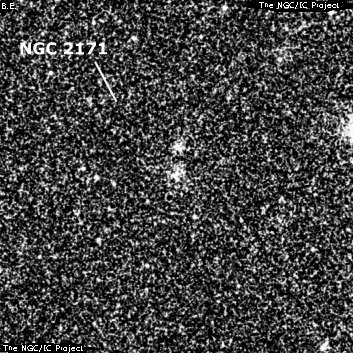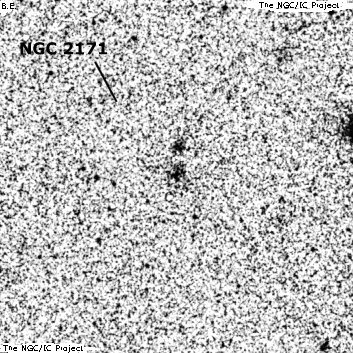NGC/IC Project Restoration Effort
(This is a very very beta version)
NGC2171


Basic Information
Location and Magnitude
Right Ascension: 5:44:13.8
Declination: -70:40:9
Constellation: MEN
Visual Magnitude:
Historic Information
Discoverer: Herschel J.
Year of discovery: 1835
Discovery aperture: 18.3
Observational
Summary description: eF, L, R, glbM
Sub-type: *Cloud
Corwin's Notes
=====
NGC 2171. Earlier (I believe sometime in the mid-2000s), I wrote about this
lost object:
I had given this up for lost, but Mati Morel found a star cloud in the LMC
that fits pretty well: the two clusters SL 691 and 692 and the surrounding
area. The contrast with the background of the LMC is subtle, but it fits
JH's description very well. JH has it as "eeF, vL, R, glbM, 4 [arcmin]"
from a single sweep (number 657 on 16 Dec 1835).
The object marked in the Hodge-Wright Atlas is a faint star about 2 arcmin
south of JH's position; ESO apparently adopted this identification, too. In
"Star Clusters", Brent makes this KMHK 1573 at 05 59 03.8 -67 53 56
(B1950.0), with no explanation of the 2.5 degree difference from JH's
declination. KMHK 1573 is too small and too faint in any case to be one of
JH's clusters.
Mati had earlier suggested that this object is identical with SL 809, a
small, faint star cluster in the LMC. While the position is not too far off
(34 seconds in RA, and 3.8 arcmin in Dec), I was skeptical because this
cluster is only 0.7 arcmin across, certainly not an object that JH would
have called "vL ... 4 [arcmin]". [While this cluster is in the position
table, it is there with two question marks, an may deserve another one or
two!]
I had finished up my [even] earlier note by saying, "So, the only other
possibility that I can see is that JH made a 10 or 20 minute error in his
RA, and that his observation applies to one of the star clouds in the
eastern end of the LMC's bar. However, this is such a stretch that I'm not
going to list any of these star clouds in the main table." Mati took me at
my word, though, and found a star cloud that matches JH's declination and
his description almost perfectly.
This is by no means, though, a solid identification. NGC 2107 is just one
minute of time preceding the star cloud, and just one arcminute north of
JH's position for NGC 2171. So, I wondered why JH did not mention that in
the same sweep. However, looking at his list of nebulae in the LMC, it's
apparent that in any given sweep, he skipped many that he recorded in other
sweeps. The nebulae and clusters were just coming by too quickly for him to
record them all, so he went over each area of the LMC several times to be
sure to catch all the objects.
In any event, Mati's star cloud, with its two embedded Shapley-Lindsay
clusters, is the best candidate I've seen for this object, so it's in the
main table, though with a colon.
Now in 2014, I finally checked the other objects in the sweep, No. 657 on 16
December 1834. All are further north than NGC 2171. That suggested a
possible error in declination, but an examination of JH's observing logs
showed no obvious error in reduction, and that this was indeed the southern-
most object that he observed that night (it is numbered 39 in the sweep).
I am still as puzzled as I was years ago, and after looking at hundreds of
JH's nebulae and star clusters in the LMC over the past month, am much less
inclined to put much weight on Mati's suggestion. JH's description just does
not match the two clusters and the surrounding field very well. Also, the
order of the object within the sweep argues firmly against an RA error -- its
entry in the sweep is followed and preceded by the objects that appear in JH's
final tables in the same order. So, I've downgraded the star-cloud hypothesis
to a question-marked possibility.
Finally, there is a galaxy pair about 1 minute 10 seconds of time east of JH's
position. However, it is probably beyond the reach of his telescope, and is
only an arcminute long in any case, far smaller than his estimate of 4 arcmin.
This pair, or at least the larger of the two galaxies, was suggested long ago
as the identification for N2171, probably by Lindsay. This idea rates three
question marks from me for all the reasons set out above.
I should also mention that Jenni Kay does not even mention NGC 2171 in her
"Visual Atlas of the Magellanic Clouds." I leave the interpretation of that
omission open until I can query her about it.
-----
Finally, in September 2016, I've checked for an eyepiece wire error. JH
records wire 2, so if he actually used wire one, the RA for 1830 would be
06 02 39; and if he used the edge of the field, the RA would be 05 59 41.
There is nothing at either position (assuming the Dec is correct), though the
galaxy pair is about 17 seconds of time -- about an arcminute -- preceding the
first, within JH's usual errors. So, I've elevated these galaxies by one
question mark, and have demoted SL 809 by a similar one question mark.
Steve's Notes
=====
NGC 2171
30" (10/13/15 - OzSky): there are no good candidates matching Herschel's description for this number, but Mati Morel suggested NGC 2171 was possibly S-L 691/692 with a large error in RA (15 min of RA). Although Corwin has since rejected this possibility as it is out of RA order in the sweep, here are the descriptions of these clusters.
S-L 691: faint or fairly faint, small, round, glow, 25" diameter. S-L 691 is the northern of close pair of LMC clusters with S-L 692 just 48" S. Located 5' ESE of NGC 2107.
S-L 692: fairly faint, fairly small, slightly elongated glow, 35" diameter, no resolution. There is no noticeable star cloud surrounding these two clusters.



